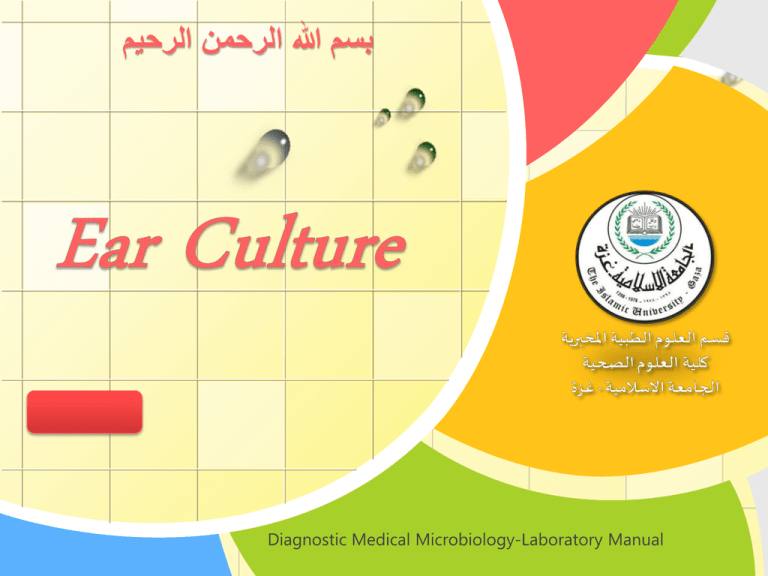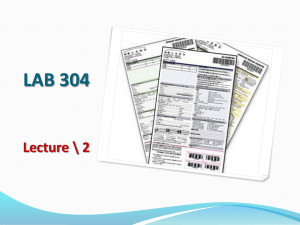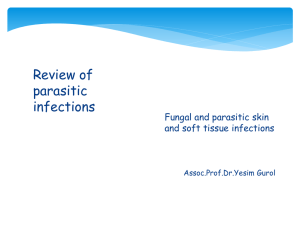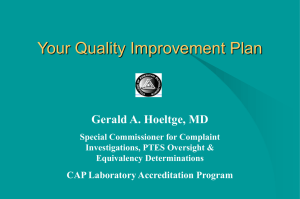Lab 11-Ear
advertisement

بسم هللا الرحمن الرحيم L/O/G/O Diagnostic Medical Microbiology-Laboratory Manual Ear Culture Aim of the test Etiological diagnosis of otitis externa or otitis media by aerobic and anaerobic culture with identification and susceptibility test of the isolated organism(s). Types of specimen Two swabs from the external or aspiration from middle ear(s). Criteria of specimen rejection Inappropriate specimen transport device; mislabeled specimen; unlabeled specimen; specimen received after prolonged delay (usually more than two hour); specimen received in expired transport media. Common Pathogens Commensals flora are present in the external ear canal Staphylococcus aureus Staphylococcus epidermidis Streptococcus pyogenes Lactobacillus spp. Pseudomonas aeruginosa Propionibacterium spp. Other Gram negative bacilli Staphylococcus aureus Streptococcus pneumoniae Various Enterobacteriaceae Haemophilus influenzae Various streptococcus spp Anaerobic bacteria Candida spp. other than albicans Proteus spp. Occasion Pseudomonas aeruginosa Pre specimen processing Who will collect the specimen Medical technologist, Microbiologist for swab from external ear. Otolaryngologist for aspiration from middle ear. Who is authorized to order the test Physician. Time relapse before processing the sample Not more than 2 hours. Storage Maintain specimen swab at room temperature. Pre specimen processing External Ear Specimen collection 1. Collect a specimen of the discharge on a thin, sterile cotton wool or Dacron swab. 2. Place the swab in a container with the transport medium, breaking off the swab stick to allow the stopper to be replaced tightly. 3. Label the specimen and send it to the laboratory. External Ear Specimen collection Specimen processing for Otitis externa Specimen processing for Otitis media Specimen processing Ear specimen submitted for culture should be inoculated to blood agar, MacConkey, and chocolate agar plates, anaerobic culture also should be setup on those specimens obtained by tympanocenthesis or those obtained from patients with chronic otitis media, or mastoiditis. Direct visual examination for material aspirated from the middle ear or mastoid is also examined directly for bacteria or fungi. Cultures from mastoid are generally taken on swabs during surgery and should be transported anaerobically. Additional information For external ear infections only Staphylococcus aureus, Streptococcus pyogenes, Pseudomonas aeruginosa, Vibrio spp. and Aspergillus will be looked for and reported. For middle ear infections only pneumococcus, Streptococcus pyogenes, Haemophilus influenzae and Staphylococcus aureus will be reported with a susceptibility test. For the chronic discharging ear, Bacteroides species and fungi will also be reported in addition to the organisms reported for middle ear infections. Post specimen processing Interfering factors: Patient on antibiotic therapy. Improper sample collection. Result reporting: Report Gram stain finding as an initial report. Report the isolated pathogen and its sensitivity pattern as a final report. Turn around time: Gram stain result should be available half hour after specimen receipt. Isolation of a possible pathogen can be expected after 2-4 days. Negative culture will be reported out 1-2 days after the receipt of the specimen. End of Lecture







